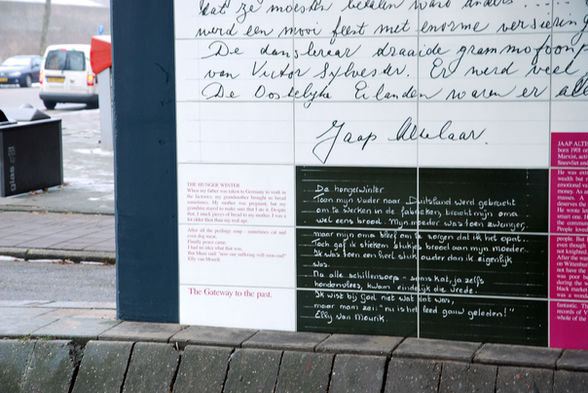installation views:
Amsterdam-Centrum, 2010
Kattenburger Triumphal Arch
In collaboration with Kristina Leko
2007 - 2010
A monument honoring the residents of the Kattenburg Island and their social and community engagement has been erected in collaboration with the community. Thus, the monument is partially created by the individuals to whom it is dedicated. It features stories written by the community members, personal histories and memories of important developments in the community.
The Kattenburg Island is a well organized working class community with several family trees living there for 100-200 years. The Kattenburgers are respected as very special people known for their independent spirit and social activism. The recent history of Kattenburg is marked by social and community initiatives: the community fought to maintain their residences on the island after the reconstruction in the 1960ies, a strong low-rent-movement in the 1970ies, the famous fight for the construction changes funded by the city in order to prevent criminal activities in the neighborhood. Historically important was also the union activism on the island. Some of important figures in the Dutch union history were Kattenburgers. Our monument documents the social engagement of individuals as well as social activities in the community in the 20th century. It honors the people and the ideas related to these initiatives.
The starting point of the project is a creative involvement of the individual members of the community in creating the monument i.e. influencing their everyday environment. The initial contacts with Kattenburgers in 2007 were successful and mediated through the community cultural center. The idea of erecting a monument dedicated to the social initiatives and their activists had an enthusiastic feedback.
In April/May 2008 a project workshop took place in the neighborhood, and lasted for 5 weeks. A leaflet was placed in every mail-box on the island inviting the Kattenburgers to write their own history themselves. 25 individuals took part in the project. Some of them came with the texts already written, some wrote their texts in the workshop, some dictated their textual statements. All texts were proofread and some also edited by a professional proofreader, and then handwritten by the authors. In its final outcome, the handwritings are applied on ceramic tiles, and cover 6 columns (12 surfaces) in the most prominent passage in the neighborhood.
Most of our participants were in their 60ies, and have been active in the activities related to the low rent movement, and other community actions in the 1970ies, 1980ies and to some extend in 1990ies. The collection of texts consists of: stories and reports about different events, memories about certain periods of time (during the war, after the war, before the war, childhood, before the renovation, moving back to Kattenburg, etc.), and portraits of individuals (about mothers and fathers, about Marie Altelaar, community activist, about Jaap Altelaar, union activist, etc.). The texts and stories mostly relate to the low rent movement. However, all the other important community actions have been described as well. There are also notes and thoughts about social and political activism and community living, philosophical thoughts about society and community, about family and friendship, about solidarity and social justice.
























